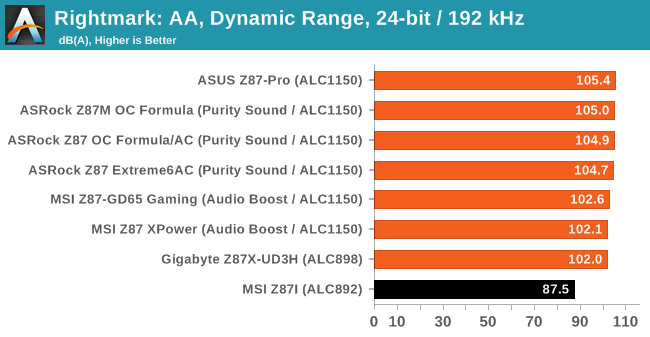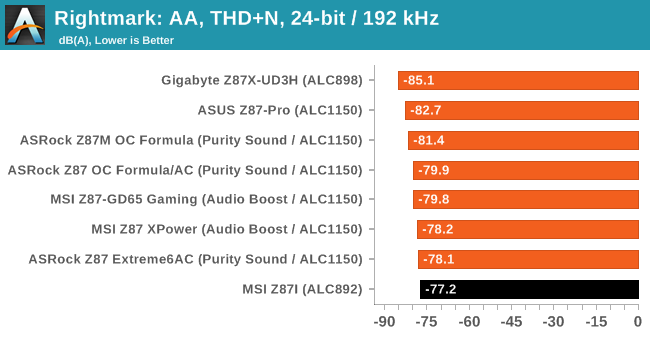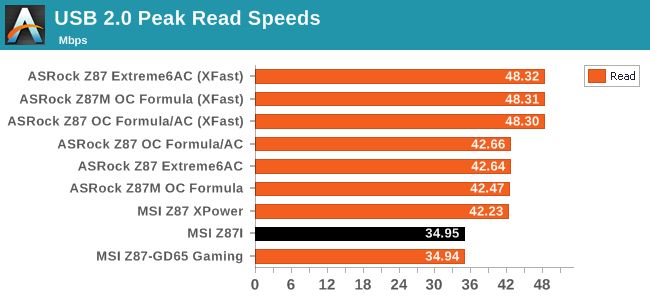MSI Z87I Review: Mini-ITX Haswell for $140
by Ian Cutress on August 27, 2013 10:15 AM EST- Posted in
- Motherboards
- MSI
- Mini ITX
- Z87
System Benchmarks
Rightmark Audio Analyzer 6.2.5
In part due to reader requests, we are pleased to include Rightmark Audio Analyzer results in our benchmark suite. The premise behind Rightmark:AA is to test the input and output of the audio system to determine noise levels, range, harmonic distortion, stereo crosstalk and so forth. Rightmark:AA should indicate how well the sound system is built and isolated from electrical interference (either internally or externally). For this test we connect the Line Out to the Line In using a short six inch 3.5mm to 3.5mm high-quality jack, turn the OS speaker volume to 100%, and run the Rightmark default test suite at 192 kHz, 24-bit. The OS is tuned to 192 kHz/24-bit input and output, and the Line-In volume is adjusted until we have the best RMAA value in the mini-pretest. We look specifically at the Dynamic Range of the audio codec used on board, as well as the Total Harmonic Distortion + Noise.


In terms of dynamic range, the ALC892 leaves a lot to be desired compared to the ALC898 and ALC1150.
USB Backup
For this benchmark, we run CrystalDiskMark to determine the ideal sequential read and write speeds for the USB port using our 240 GB OCZ Vertex3 SSD with a SATA 6 Gbps to USB 3.0 converter. Then we transfer a set size of files from the SSD to the USB drive using DiskBench, which monitors the time taken to transfer. The files transferred are a 1.52 GB set of 2867 files across 320 folders – 95% of these files are small typical website files, and the rest (90% of the size) are the videos used in the WinRAR test. In an update to pre-Z87 testing, we also run MaxCPU to load up one of the threads during the test which improves general performance up to 15% by causing all the internal pathways to run at full speed.


Nothing particularly special about USB speeds, in line with other Z87 MSI motherboards tested in the past.
DPC Latency
Deferred Procedure Call latency is a way in which Windows handles interrupt servicing. In order to wait for a processor to acknowledge the request, the system will queue all interrupt requests by priority. Critical interrupts will be handled as soon as possible, whereas lesser priority requests, such as audio, will be further down the line. So if the audio device requires data, it will have to wait until the request is processed before the buffer is filled. If the device drivers of higher priority components in a system are poorly implemented, this can cause delays in request scheduling and process time, resulting in an empty audio buffer – this leads to characteristic audible pauses, pops and clicks. Having a bigger buffer and correctly implemented system drivers obviously helps in this regard. The DPC latency checker measures how much time is processing DPCs from driver invocation – the lower the value will result in better audio transfer at smaller buffer sizes. Results are measured in microseconds and taken as the peak latency while cycling through a series of short HD videos - under 500 microseconds usually gets the green light, but the lower the better.

Peak DPC latency for Z87 platforms continues to poll over 145 microseconds, suggesting that is still a generational issue. If you want lower, then something other than Z87 might suffice.










46 Comments
View All Comments
Touche - Wednesday, August 28, 2013 - link
Do you test DPC latency with MBO software installed/running or without it?SteelRing - Thursday, August 29, 2013 - link
Is that a TOSLINK/Optical above the HDMI? Why is that not listed?TrevorH - Monday, September 2, 2013 - link
Glad to see that there are so many others who stopped reading this as soon as they saw "Realtek". Manufacturers, please note: Realtek NICs are not a selling point.Tujan - Friday, September 6, 2013 - link
I would be interested in any problem running these smaller boards with a graphics card . Then how if any problems or changes would occur within the specs. performance when a graphics card is used. Then how the board/board manufactures/bios handles the controls-settings differently. Or the feature set with the board manufacturer to do so (run with,disable onboard video within cpu).I've noticed some articles that describe certain inconsistency with mb components when utilizing them (the small boards) with graphics cards. Instead of the apu . Thanks.
smayonak - Tuesday, September 17, 2013 - link
Hello Ian, would you happen to know if this board is capable of undervolting (voltage offset)? I read through the article a couple times, but couldn't find anything relating to this. My apologies if you've mentioned it already.ozark - Sunday, September 29, 2013 - link
I just got this myself but hasn't had the chance to put things together. One thing I noticed is the connector next to hdmi port (1 pin-blank-4pins). They don't have it listed in the manual. Any one know what it is?